Biology and biotechnology of follicle development
- PMID: 22666170
- PMCID: PMC3366219
- DOI: 10.1100/2012/938138
Biology and biotechnology of follicle development
Abstract
Growth and development of ovarian follicles require a series of coordinated events that induce morphological and functional changes within the follicle, leading to cell differentiation and oocyte development. The preantral early antral follicle transition is the stage of follicular development during which gonadotropin dependence is obtained and the progression into growing or atresia of the follicle is made. Follicular growth during this period is tightly regulated by oocyte-granulosatheca cell interactions. A cluster of early expressed genes is required for normal folliculogenesis. Granulosa cell factors stimulate the recruitment of theca cells from cortical stromal cells. Thecal factors promote granulosa cell proliferation and suppress granulosa cell apoptosis. Cell-cell and cell-extracellular matrix interactions influence the production of growth factors in the different follicular compartments (oocyte, granulosa, and theca cells). Several autocrine and paracrine factors are involved in follicular growth and differentiation; their activity is present even at the time of ovulation, decreasing the gap junction communication, and stimulating the theca cell proliferation. In addition, the identification of the factors that promote follicular growth from the preantral stage to the small antral stage may provide important information for the identification for assisted reproduction techniques.
Figures
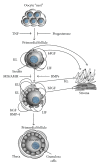
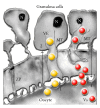
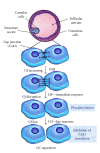
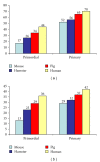
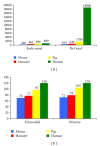

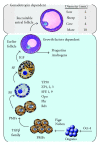
Similar articles
-
Oocyte-granulosa-theca cell interactions during preantral follicular development.J Ovarian Res. 2009 Jul 9;2(1):9. doi: 10.1186/1757-2215-2-9. J Ovarian Res. 2009. PMID: 19589134 Free PMC article.
-
Growth differentiation factor 9 is antiapoptotic during follicular development from preantral to early antral stage.Mol Endocrinol. 2006 Oct;20(10):2456-68. doi: 10.1210/me.2005-0357. Epub 2006 Jun 1. Mol Endocrinol. 2006. PMID: 16740654
-
Regulation of granulosa and theca cell transcriptomes during ovarian antral follicle development.Mol Reprod Dev. 2008 Sep;75(9):1457-72. doi: 10.1002/mrd.20883. Mol Reprod Dev. 2008. PMID: 18288646 Free PMC article.
-
Local roles of TGF-beta superfamily members in the control of ovarian follicle development.Anim Reprod Sci. 2003 Oct 15;78(3-4):165-83. doi: 10.1016/s0378-4320(03)00089-7. Anim Reprod Sci. 2003. PMID: 12818643 Review.
-
The mechanisms that control the preantral to early antral follicle transition and the strategies to have efficient culture systems to promote their growth in vitro.Zygote. 2023 Aug;31(4):305-315. doi: 10.1017/S0967199423000254. Epub 2023 May 24. Zygote. 2023. PMID: 37221099 Review.
Cited by
-
Regulation of secondary follicle growth by theca cells and insulin-like growth factor 1.J Reprod Dev. 2015;61(3):161-8. doi: 10.1262/jrd.2014-107. Epub 2015 Feb 6. J Reprod Dev. 2015. PMID: 25740252 Free PMC article.
-
Genome-wide differential mRNA expression profiles in follicles of two breeds and at two stages of estrus cycle of gilts.Sci Rep. 2017 Jul 11;7(1):5052. doi: 10.1038/s41598-017-04336-x. Sci Rep. 2017. PMID: 28698542 Free PMC article.
-
High-throughput analysis of ovarian granulosa cell transcriptome.Biomed Res Int. 2014;2014:213570. doi: 10.1155/2014/213570. Epub 2014 Mar 10. Biomed Res Int. 2014. PMID: 24711992 Free PMC article. Review.
-
Single-cell RNA-seq analysis and cell-cluster deconvolution of the human preovulatory follicular fluid cells provide insights into the pathophysiology of ovarian hyporesponse.Front Endocrinol (Lausanne). 2022 Oct 21;13:945347. doi: 10.3389/fendo.2022.945347. eCollection 2022. Front Endocrinol (Lausanne). 2022. PMID: 36339426 Free PMC article.
-
Kelulut Honey Improves Folliculogenesis, Steroidogenic, and Aromatase Enzyme Profiles and Ovarian Histomorphology in Letrozole-Induced Polycystic Ovary Syndrome Rats.Nutrients. 2022 Oct 18;14(20):4364. doi: 10.3390/nu14204364. Nutrients. 2022. PMID: 36297046 Free PMC article.
References
-
- Ireland JJ, Zielak-Steciwko AE, Jimenez-Krassel F, et al. Variation in the ovarian reserve is linked to alterations in intrafollicular estradiol production and ovarian biomarkers of follicular differentiation and oocyte quality in cattle. Biology of Reproduction. 2009;80(5):954–964. - PubMed
-
- Fortune JE. The early stages of follicular development: Activation of primordial follicles and growth of preantral follicles. Animal Reproduction Science. 2003;78(3-4):135–163. - PubMed
-
- Skinner MK. Regulation of primordial follicle assembly and development. Human Reproduction Update. 2005;11(5):461–471. - PubMed
-
- McNatty KP, Fidler AE, Juengel JL, et al. Growth and paracrine factors regulating follicular formation and cellular function. Molecular and Cellular Endocrinology. 2000;163(1-2):11–20. - PubMed
-
- Hyttel P, Sinowatz F, Vejlsted M. Domestic Animal Embryology. Edinburgh, UK: Saunders Elsevier; 2010.
Publication types
MeSH terms
LinkOut - more resources
Full Text Sources
Miscellaneous

